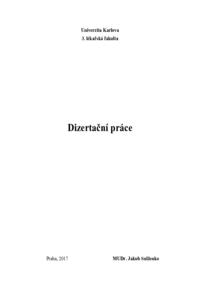Degenerativní změny chlopenních bioprotéz po katetrizační implantaci aortální chlopně a možnosti jejich prevence
Degenerative changes of valvular bioprosthesis after transcatheter aortic valve implantation and possibilities of their prevention
dissertation thesis (DEFENDED)

View/
Permanent link
http://hdl.handle.net/20.500.11956/191240Identifiers
Study Information System: 132619
Collections
- Kvalifikační práce [3244]
Author
Advisor
Referee
Kovárník, Tomáš
Kala, Petr
Faculty / Institute
Third Faculty of Medicine
Discipline
Preventive Medicine
Department
Department of Cardiology 3FM CU and UHKV
Date of defense
11. 12. 2017
Publisher
Univerzita Karlova, 3. lékařská fakultaLanguage
Czech
Grade
Pass
v českém jazyce: Úvod: Prozatím je známo velmi málo o degenerativních změnách aortálních bioprotéz po TAVI, které mohou mít zásadní vliv na dlouhodobou prognózu pacientů po tomto výkonu. Cíl: Zhodnotit degenerativní změny bioprotéz po TAVI s použitím CT a nálezy porovnat s degenerativními změna bioprotéz po chirurgické náhradě chlopně (AVR). Dále porovnat hodnoty zánětlivých markerů u obou skupin pacientů a zhodnotit jejich možnou roli v procesu degenerace protéz. Metodika a výsledky: 49 pacientů po TAVI a 29 pacientů v kontrolní skupině po chirurgické AVR podstoupilo 2 leté sledování. Kontrolu po 5 letech absolvovalo 8 pacientů po TAVI a 7 po AVR. U všech těchto pacientů bylo provedeno CT se zhodnocením kalcifikací na cípech bioprotéz s použitím Agatsonova kalciového skóre. Pacienti po TAVI byli starší než pacienti po AVR [82 (62;86) vs. 74 (64;84), p <0.001], měli více komorbidit - vyšší EuroScore I [21.0 (5.0;46.0) vs. 6.15 (2.54;11.17), p<0.001], častější ICHS (69.4% vs. 13.8%, p<0.001) a častější anamnézu předchozí kardiochirurgické operace (32.7% vs 0.0%, p<0.001). Lehké kalcifikace (průměrné Agatsonovo skóre 50,76) na cípech protézy byly nalezeny u 2 pacientů 4-5 let po TAVI a u 1 pacienta 2 roky po AVR (p=NS). Ačkoliv byly nalezeny významné rozdíly v hodnotách TNF-α a E-selectinu před...
v anglickém jazyce: Background: Little is known about the valve degeneration process after transcutaneous aortic valve implantations (TAVI) that can have an important impact on patients' long-term prognosis. Aim: To evaluate degenerative changes of TAVI using computed tomography (CT) compared to findings in patients that underwent surgical aortic valve replacement (SAVR). Subsequently, to compare the level of immune and inflammatory markers in both groups and test their possible role in the valve degeneration process. Methods and results: 49 patients after TAVI and 29 patients in the control group after SAVR underwent 2 years of follow-up and 8 patients from the TAVI group and 7 patients after SAVR underwent five years of follow-up. CT was performed in all patients and calcifications on prosthesis cusps in both groups were measured using Agatson calcium score. TAVI patients were older compared to patients who underwent SAVR [82 (62;86) vs. 74 (64;84) years, p < 0.001], and had more comorbidities - higher EuroScore I [21.0 (5.0;46.0) vs. 6.15 (2.54;11.17), p < 0.001]. T A VI patients had more often concomitant coronary artery disease (69.4% vs. 13.8%, p < 0.001) and previous history of cardiac surgery (32.7% vs. 0.0%, p < 0.001). Slight calcifications (mean Agatson score 50.76) on prosthetic cusps...
